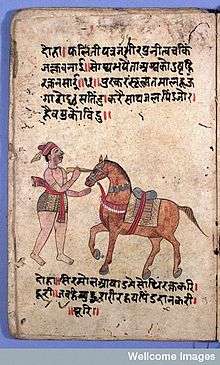Shalihotra
The Shalihotra Samhita is an early Indian treatise on veterinary medicine (hippiatrics), likely composed in the 3rd century BCE.[1]

It is attributed to one Shalihotra son of Hayagosha, considered the founder of veterinary sciences in Indian tradition. He is said to have lived in Sravasti (modern Sahet-Mahet on the borders of Gonda and Bahraich districts in Uttar Pradesh).
Text
Shalihotra's principal work was a large treatise on the care and management of horses, the Shalihotra Samhita (encyclopedia of the physician Shalihotra) having some 12,000 shlokas in Sanskrit. It has been translated into Persian, Arabic, Tibetan and English languages. This work described equine and elephant anatomy, physiology, surgery and diseases with their curative and preventive measures. It elaborated on the body structures of different races of horses, and identified the structural details by which one can determine the age of a horse. Two other works, namely Asva-prashnsa and Asva-lakshana sastram are also attributed to Shalihotra.
Some of the later authors have named their veterinary works after Shalihotra and others have based their work on his Samhita. Subsequent generations copied, revised and added to Shalihotra's text—one of these later texts is shown in the illustration above. Hence, the term "Shalihotra" refers to similar texts in a tradition. Muni Palkapya wrote Hasti Ayurveda, covering all aspects of elephant medicine. This book has four sections and 152 chapters, including the anatomy of elephants. During Mahabharat period, Nakul, author of the Ashva-chikitsa, was considered an equine expert, while Sahdev was a specialist in cattle management.
Horses and elephants were vital assets in the never-ending warfare of the ancient world. Physicians treating human beings were also trained in the care of animals. Ancient Indian medical treatises such as those of Charaka, Sushruta and Harita contain chapters or references about the care of diseased, as well as healthy, animals.
Author
Shalihotra and the sage Agnivesa may have been pupils of the same teacher; according to tradition, Bharadwaja's Ayurveda, the science of life, was first presented in text form by Agnivesa, in his book the Agnivesh tantra and later by Charaka (Charaka Samhita, encyclopedia of the physician Charaka). Others assert the great surgeon Acharya Sushruta, author of Sushruta Samhita (encyclopedia of the physician Sushruta), may have been Shalihotra's pupil.[2]
See also
- Ayurveda
- History of veterinary medicine
- Hippiatrica
- History of the horse in South Asia
References
- "In Ashokan times, there was great advance in veterinary science. For treatment of elephants, 'Palkapya samhita' and for treatment of horses, 'Shalihotra samhita' were written." K. Jamanadas, Decline and Fall of Buddhism: A Tragedy in Ancient India (2004), p. 235.
- "Ayurveda: Medical Practice", A Concise History of Science, Atma Ram & Sons Archived 2006-05-15 at the Wayback Machine
Literature
- Apte, M. S. "Selected articles from Salihotra's Asvasastra." Indian veterinary journal 15 (1938): 415-420.
- Froehner, R. "Salihotra." Veterinärhistorische Mitteilungen 2, no. 1 (1922): 1-2.